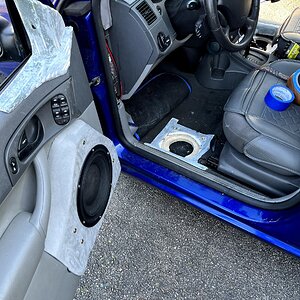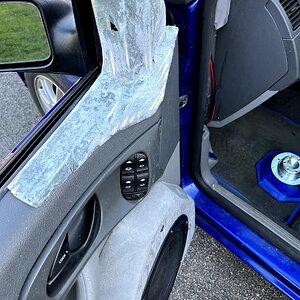Steve16Accord
CarAudio.com Newbie
- 4
I have scoured the Internet and searched for an answer on here, but cannot find one. It could be me and the search criteria I am using, but if not I'm hoping you all can help. So I understand what happens with ohm loads when wiring two speakers either parallel or bridged, but I need your help determining potential issues by bridging two 3-ohm speakers. I have recently completed an audio upgrade on my Honda Accord Sport, and while it's taken me a year and sounds better than stock, I still want to figure out how I can make it sound even better.
So before I go further, here's my setup thus far.
Pioneer AVH-2440NEX
Soundstream PN5.640D (5-channel amp)
Infinity Primus 6.5" Components (Front) - wired to channels 1 & 2
Infinity Reference 6.5" Coaxials (Rear) - wired to channels 3 & 4
Rockford Fosgate 12" DVC subwoofer in sealed box - wired to channel 5 (sub wired to 2-ohms)
Now, the other day I started wondering what it would sound like if I disconnected the rear deck speakers, and wired the components bridged to channels 1/2 and 3/4. I am aware that rear speakers "fill the space" so to speak, but I know some people chose to not run them altogether. The amp is 2-ohm stable and classified as a Class D unit. Bridged, channels 1/2 and 3/4 put out 160 watts RMS each, which according to the specs on the components, is still well within recommended RMS operating range. The thing I cannot wrap my head around though, is that this rating is based on a 4-ohm load. Per the manual, by running the amp in a 3 channel setup, channels 1/2 and 3/4 show a recommended ohm range of 4 to 8 ohms. If the components are 3-ohms and I bridge them, would I cause damage to the speakers or amp? My gut says no since the amp is stable down to 2-ohms, but the 4 to 8 ohm reference in the manual has me thinking otherwise. The components, of course, come with a passive crossover, which I will keep connected. I have a high pass set at 100Hz at the HU, to filter out lower frequencies prior to the audio signal hitting the amp. I know the passive crossover is suppose to do that job, but from my understanding, you can still use a crossover on the source unit if you want. I figure, weed out the unnecessary lower frequencies first, then let passives take over. It sounds better to me doing it this way as well. Here are the links to the products in question from Crutchfield.
https://www.crutchfield.com/p_530PN5640D/Soundstream-Picasso-Nano-PN5-640D.html?search=PN5.640D&skipvs=T
https://www.crutchfield.com/p_108P6500CS/Infinity-Primus-PR6500cs.html?search=infinity+primus+pr6500cs&osp=infinity+primus+pr6500cs
I appreciate your help.
Steve
So before I go further, here's my setup thus far.
Pioneer AVH-2440NEX
Soundstream PN5.640D (5-channel amp)
Infinity Primus 6.5" Components (Front) - wired to channels 1 & 2
Infinity Reference 6.5" Coaxials (Rear) - wired to channels 3 & 4
Rockford Fosgate 12" DVC subwoofer in sealed box - wired to channel 5 (sub wired to 2-ohms)
Now, the other day I started wondering what it would sound like if I disconnected the rear deck speakers, and wired the components bridged to channels 1/2 and 3/4. I am aware that rear speakers "fill the space" so to speak, but I know some people chose to not run them altogether. The amp is 2-ohm stable and classified as a Class D unit. Bridged, channels 1/2 and 3/4 put out 160 watts RMS each, which according to the specs on the components, is still well within recommended RMS operating range. The thing I cannot wrap my head around though, is that this rating is based on a 4-ohm load. Per the manual, by running the amp in a 3 channel setup, channels 1/2 and 3/4 show a recommended ohm range of 4 to 8 ohms. If the components are 3-ohms and I bridge them, would I cause damage to the speakers or amp? My gut says no since the amp is stable down to 2-ohms, but the 4 to 8 ohm reference in the manual has me thinking otherwise. The components, of course, come with a passive crossover, which I will keep connected. I have a high pass set at 100Hz at the HU, to filter out lower frequencies prior to the audio signal hitting the amp. I know the passive crossover is suppose to do that job, but from my understanding, you can still use a crossover on the source unit if you want. I figure, weed out the unnecessary lower frequencies first, then let passives take over. It sounds better to me doing it this way as well. Here are the links to the products in question from Crutchfield.
https://www.crutchfield.com/p_530PN5640D/Soundstream-Picasso-Nano-PN5-640D.html?search=PN5.640D&skipvs=T
https://www.crutchfield.com/p_108P6500CS/Infinity-Primus-PR6500cs.html?search=infinity+primus+pr6500cs&osp=infinity+primus+pr6500cs
I appreciate your help.
Steve


